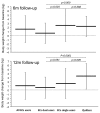Lack of Substantial Post-Cessation Weight Increase in Electronic Cigarettes Users
- PMID: 29570695
- PMCID: PMC5923623
- DOI: 10.3390/ijerph15040581
Lack of Substantial Post-Cessation Weight Increase in Electronic Cigarettes Users
Abstract
Minimization of post-cessation weight gain in quitters is important, but existing approaches (e.g., antismoking medications) shows only limited success. We investigated changes in body weight in smokers who quit or reduced substantially their cigarette consumption by switching to electronic cigarettes (ECs) use. Body weight and smoking/vaping history were extracted from medical records of smokers and ex-smokers to match three study groups: (1) regular EC users on at least two consecutive follow-up visits; (2) regular smokers (and not using ECs); (3) subjects who reported sustained smoking abstinence after completing a cessation program. Review of their medical records was conducted at two follow-up visits at 6- (F/U 6m) and 12-months (F/U 12m). A total of 86 EC users, 93 regular smokers, and 44 quitters were studied. In the EC users study group, cigarettes/day use decreased from 21.1 at baseline to 1.8 at F/U 12m (p < 0.0001). Dual usage was reported by approximately 50% of EC users. Both within factor (time, p < 0.0001) and between factor (study groups, p < 0.0001) produced significant effect on weight (% change from baseline), with a significant 4.8% weight gain from baseline in the quitters study group at F/U 12m. For the EC users, weight gain at F/U 12m was only 1.5% of baseline. There was no evidence of post-cessation weight increase in those who reduced substantially cigarette consumption by switching to ECs (i.e., dual users) and only modest post-cessation weight increase was reported in exclusive EC users at F/U 12m. By reducing weight gain and tobacco consumption, EC-based interventions may promote an overall improvement in quality of life.
Keywords: electronic cigarette; smoking cessation; smoking reduction; tobacco harm reduction; weight gain.
Conflict of interest statement
Riccardo Polosa is a full-time employee of the University of Catania, Italy. In relation to his work in the area of tobacco control, Riccardo Polosa has received lecture fees and research funding from Pfizer and GlaxoSmithKline, manufacturers of stop smoking medications. He has also served as a consultant for Pfizer, Global Health Alliance for treatment of tobacco dependence, ECITA (Electronic Cigarette Industry Trade Association, in the UK) and Health Diplomat (consulting company that delivers solutions to global health problems with special emphasis on harm minimization). Lecture fees from a number of European electronic cigarette industry and trade associations (including FIVAPE in France and FIESEL in Italy) were directly donated to vaper advocacy non-profit organizations. He is currently scientific advisor for LIAF, Lega Italiana Anti Fumo (Italian acronym for Italian Anti Smoking League) and Head of the European Technical Committee for standardization on “Requirements and test methods for emissions of electronic cigarettes” (CEN/TC 437; WG4). The other authors have no conflict of interests.
Figures

References
-
- US Department of Health and Human Services . The Health Consequences of Smoking—50 Years of Progress: A Report of the Surgeon General. US Department of Health and Human Services; Atlanta, Georgia: 2014.
-
- World Health Organization . WHO Report on the Global Tobacco Epidemic, 2008—The MPOWER Package. World Health Organization; Geneva, Switzerland: 2008.
-
- Doll R., Peto R., Boreham J., Sutherland I. Mortality in relation to smoking: 50 years’ observations on male British doctors. BMJ. 2004;328:1519. doi: 10.1136/bmj.38142.554479.AE. - DOI - PMC - PubMed
-
- U.S. Department of Health and Human Services . The Health Benefits of Smoking Cessation: A Report of the Surgeon General. U.S. Department of Health and Human Services; Rockville, MD, USA: 1990.
Publication types
MeSH terms
LinkOut - more resources
Full Text Sources
Other Literature Sources
Medical

